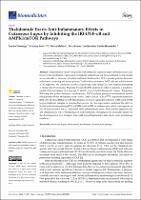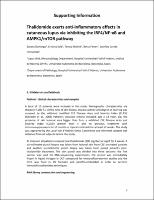| dc.contributor | Vall d'Hebron Barcelona Hospital Campus |
| dc.contributor.author | Domingo Bover, Sandra |
| dc.contributor.author | Solé Marce, Cristina |
| dc.contributor.author | Moline Marimon, Teresa |
| dc.contributor.author | Ferrer Fábrega, Berta |
| dc.contributor.author | Cortés Hernandez, Josefina |
| dc.date.accessioned | 2022-06-15T12:56:02Z |
| dc.date.available | 2022-06-15T12:56:02Z |
| dc.date.issued | 2021-12 |
| dc.identifier.citation | Domingo S, Solé C, Moliné T, Ferrer B, Cortés-Hernández J. Thalidomide Exerts Anti-Inflammatory Effects in Cutaneous Lupus by Inhibiting the IRF4/NF-ҡB and AMPK1/mTOR Pathways. Biomedicines. 2021 Dec;9(12):1857. |
| dc.identifier.issn | 2227-9059 |
| dc.identifier.uri | https://hdl.handle.net/11351/7690 |
| dc.description | Cutaneous lupus; Mechanism of action; Thalidomide |
| dc.description.abstract | Thalidomide is effective in patients with refractory cutaneous lupus erythematosus (CLE). However, the mechanism of action is not completely understood, and its use is limited by its potential, severe side-effects. Immune cell subset analysis in thalidomide’s CLE responder patients showed a reduction of circulating and tissue cytotoxic T-cells with an increase of iNKT cells and a shift towards a Th2 response. We conducted an RNA-sequencing study using CLE skin biopsies performing a Therapeutic Performance Mapping System (TMPS) analysis in order to generate a predictive model of its mechanism of action and to identify new potential therapeutic targets. Integrating RNA-seq data, public databases, and literature, TMPS analysis generated mathematical models which predicted that thalidomide acts via two CRBN-CRL4A- (CRL4CRBN) dependent pathways: IRF4/NF-ҡB and AMPK1/mTOR. Skin biopsies showed a significant reduction of IRF4 and mTOR in post-treatment samples by immunofluorescence. In vitro experiments confirmed the effect of thalidomide downregulating IRF4 in PBMCs and mTOR in keratinocytes, which converged in an NF-ҡB reduction that led to a resolution of the inflammatory lesion. These results emphasize the anti-inflammatory role of thalidomide in CLE treatment, providing novel molecular targets for the development of new therapies that could avoid thalidomide’s side effects while maintaining its efficacy. |
| dc.language.iso | eng |
| dc.publisher | MDPI |
| dc.relation.ispartofseries | Biomedicines;9(12) |
| dc.rights | Attribution 4.0 International |
| dc.rights.uri | http://creativecommons.org/licenses/by/4.0/ |
| dc.source | Scientia |
| dc.subject | Lupus eritematós - Tractament |
| dc.subject | Medicaments immunosupressors - Ús terapèutic |
| dc.subject | Avaluació de resultats (Assistència sanitària) |
| dc.subject.mesh | Lupus Erythematosus, Cutaneous |
| dc.subject.mesh | /drug therapy |
| dc.subject.mesh | Immunosuppressive Agents |
| dc.subject.mesh | Treatment Outcome |
| dc.title | Thalidomide Exerts Anti-Inflammatory Effects in Cutaneous Lupus by Inhibiting the IRF4/NF-ҡB and AMPK1/mTOR Pathways |
| dc.type | info:eu-repo/semantics/article |
| dc.identifier.doi | 10.3390/biomedicines9121857 |
| dc.subject.decs | lupus eritematoso cutáneo |
| dc.subject.decs | /farmacoterapia |
| dc.subject.decs | inmunosupresores |
| dc.subject.decs | resultado del tratamiento |
| dc.relation.publishversion | https://doi.org/10.3390/biomedicines9121857 |
| dc.type.version | info:eu-repo/semantics/publishedVersion |
| dc.audience | Professionals |
| dc.contributor.organismes | Institut Català de la Salut |
| dc.contributor.authoraffiliation | [Domingo S, Solé C, Cortés-Hernández J] Unitat de Lupus, Servei de Reumatologia, Vall d’Hebron Hospital Universitari, Barcelona, Spain. Vall d’Hebron Institut de Recerca (VHIR), Barcelona, Spain. Universitat Autònoma de Barcelona, Bellaterra, Spain. [Moliné T, Ferrer B] Servei de Patologia, Vall d’Hebron Hospital Universitari, Barcelona, Spain. Universitat Autònoma de Barcelona, Bellaterra, Spain |
| dc.identifier.pmid | 34944673 |
| dc.identifier.wos | 000735571000001 |
| dc.relation.projectid | info:eu-repo/grantAgreement/ES/PE2013-2016/PI15%2F02145 |
| dc.rights.accessrights | info:eu-repo/semantics/openAccess |


